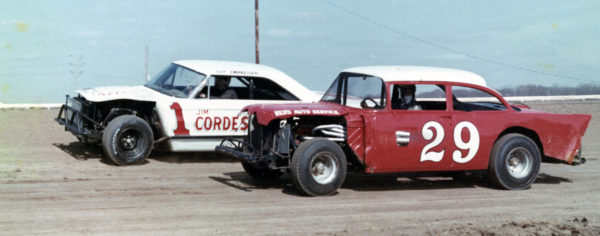By Jim Volgarino

Red Droste (29) and Bill Zwanziger (1) were two of the most aggressive competitors during their years racing both on the Tunis track and at tracks all over the Midwest. Fans of both drivers knew the racing was going to be extra exciting when these two were on the track at the same time.
Historians agree the automobile literally changed the landscape of the world, particularly in the United States where people in just a few years were able to travel longer distances in shorter periods of time. Motorized transportation, though initially invented in Germany, quickly caught the imagination of the U.S. population and it didn’t take long for competitive automobile racing to become an important part of the growth of the budding industry.
The very first sanctioned automobile race, held in Chicago, Ill., in November 1895, had future ties to Waterloo when the winner of that 52-mile race, J. Frank Duryea, showed up in Waterloo a few years later with his brother, Charles, to build cars. The race, staged in a snowstorm, was widely publicized in the nation’s newspapers and gave the brothers the kind of exposure they wanted to become a major automobile manufacturer.
The Cedar Valley area had grown in prominence as a premier manufacturing location for gasoline powered machinery and the automobile was an obvious application. The Duryeas came to Waterloo along with others who saw the potential of having this new-fangled technology make the horseless carriage a primary mode of transportation. Though the brothers only built vehicles for a couple of years in Waterloo, they helped signal the big changes to come.
Iowa was somewhat removed from the very earliest powered “devil machines” but the enthusiasm for the contraptions grew rapidly once those in the heartland realized there was a more efficient and faster means of traveling from point A to point B.
Cedar Valley saw more powered carriages on streets and roads during the early 1900s and racing venues developed, initially to race horses, but later allowing automobiles onto the dirt ovals to vie for speed records to the cheers of excited spectators. Both Waterloo and Cedar Falls hosted automobile competitions up until approximately 1910 and dropped away from organized racing of any type for the next 30 years.
In 1947, Judd L. Tunis, a local meat cutter, decided he wanted a place where he could exercise his horses and stage some races. He expressed a distaste for having to load his horses up and haul them 25 miles to Waverly to get them on a track. So, he took matters into his own hands and built a half-mile horse track, complete with bleachers.
TO READ THE ENTIRE STORY AND OTHER FASCINATING STORIES ABOUT IOWA HISTORY, subscribe to Iowa History Journal. You can also purchase back issues at the store.
